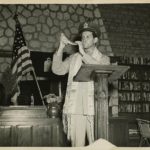A Time to Reflect
by Rachel Rudman, M.A., Reference Services Research Intern, Center for Jewish History
This post is part of the Holiday History Series. To view all posts in the series, click here.
Above image: Text on back of photograph: “Chaplain Joseph H. Freedman Hq, USAFIME, is shown blowing the ‘Shofar’ during the annual religious service in observance of Rosh-Hashana. Photo by Sgt. E.M. Henderson, S.C., Signal Corps Photo Division, USAFIME.” Circa 1942. c/o American Jewish Historical Society.
Since the high holidays draw the highest number of Jews to synagogue during the Jewish year, it is an apt time for congregational leaders to speak and write on topics of interest or concern to their communities. Sermons and bulletins on Rosh Hashanah, for example, typically inspire reflection on the past year and describe hopes for the year ahead.
As I noted in my previous post, records from the National Jewish Welfare Board (NJWB)—housed in the American Jewish Historical Society collections here at the Center—allow us to see which world events were most relevant to Jews at specific time periods, as well as the thematic ways in which Jewish community leaders connected these events to the Jewish New Year.
The first example comes from a bulletin called “The Synagogue Light” by Rabbi Joseph Hager. On Rosh Hashanah 1941, in the midst of the Holocaust, he writes that as Jewish communities blow the ram’s horn, they should reflect on the innumerable losses in blood and treasure of the Jewish people in many parts of the world. He explains that over the past year Jews have been persecuted, their existence as a people has been threatened, and they have been made to experience the suffering of the dark ages. He expresses hope that on this Rosh Hashanah, prayer will hasten the coming of well-being for humanity, and that the new year will be one of deliverance and salvation for the Jewish people. (AJHS I-337, subgroup 1, series C, subseries 4, box 168, Folder 9. Click here for the finding aid.)
Another example comes in the form of a New Year message from Dr. Louis Finkelstein, President of the Jewish Theological Seminary of America in 1945. He begins by saying that as the enemies of democracy in Europe and Asia have been defeated, and men begin to return to their regular lives, it is a fitting on Rosh Hashanah to reflect upon the events of the past six years. He writes that even while much is being done to repair the world after the physical destruction of WWII, that the most important goal moving forward is to lay the foundation of lasting peace among nations. He connects this call for cooperation among mankind to the Rosh Hashanah themes of renewed heart and spirit. He puts forth the hope that as Jews help to rebuild the world and repopulate the Jewish people, that they focus on the establishment of Israel as a shelter for those in need and the education of children about the importance of a life devoted to Jewish values. (AJHS I-337, subgroup 1, series C, subseries 4, box 168, Folder 10. Click here for the finding aid.)
A final example comes from the President’s Message in the Mizrachi Women’s Cultural Guide on Rosh Hashanah 1948. She says that this is the first Jewish New Year since the creation of Israel and thanks God for the great events of the past year. In asking for peace and security of the new country, the President notes the importance of determined and loyal Zionists in the essential building up of the land, including its schools, agriculture and army. She hopes, on Rosh Hashanah, for the continued privilege of contributing to the growth of the Jewish people and the new state of Israel. (AJHS I-337, subgroup 1, series C, subseries 4, box 168, Folder 11. Click here for the finding aid.)
Best wishes for a sweet new year, full of meaningful reflection on the past and hope for the future. Check back for a look into past Jewish communities through the lens of Yom Kippur sermons and bulletins.


